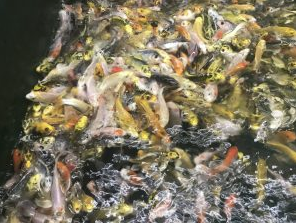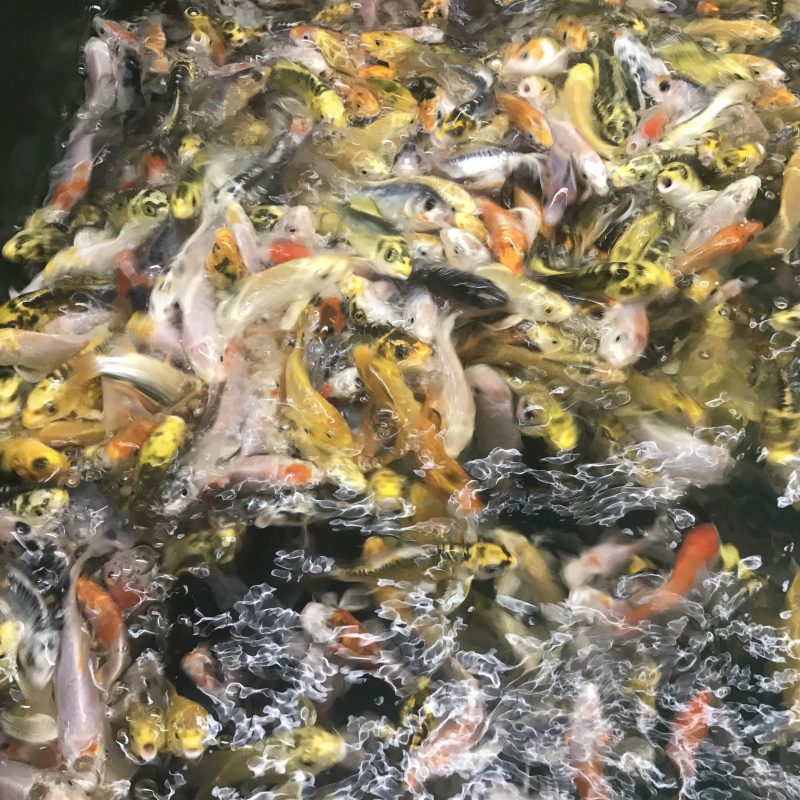Perhaps the most common question that we receive from customers is that of stocking density. New hobbyists have a fresh pond or tank that they are ready to stock. But, they want to be responsible hobbyists and don’t want to overstock, risking the health and happiness of the fish that they are committed to keeping.
So, they figure “I’ll ask a pro, they can easily tell me how many fish to put in my pond!” But, sadly, it’s not an easy or straightforward answer. There are several variables and considerations that go into a proper stocking density for any given system.
The Stocking “Rule of Thumb”
Spend any amount of time around koi keepers, and you are bound to hear the stocking density rule of thumb – “one inch of Koi for every 10 gallons of water.” While this may be a good starting point, it is far from a “rule”.
Consider that commercial operations, such as Blue Ridge Koi or Hazorea Aquatics, keep Koi in tanks at stocking densities that are insanely higher than 1 inch of fish per 10 gallons of water. Blue Ridge can keep 500 four inch fish in a 500-gallon tank. That is four inches of Koi for every gallon of water, forty times higher than the one inch of fish for 10 gallons of water rule.
Now, Blue Ridge will have tens of thousands of dollars invested in that system and will be using techniques that are not typical for a hobbyist. As a hobbyist, you shouldn’t be trying to cram as many fish as you can into your pond. You should be looking for the stocking density that allows you to enjoy your pond without an overload of work, as well as ensuring a happy and healthy environment for your Koi.
So, let’s take a look at some factors.
Filtration

NOTE: All discussion of filtration in this article assumes that your filtration is fully “cycled”. Take an in-depth look at biological filtration.
Filtration is vitally important when considering your proper stocking density. Koi are ravenous eaters, and along with that voracious appetite comes a lot of waste. Your stocking density will depend heavily on the amount of mechanical and biological filtration on your pond or tank, and how well that filtration can keep up with removing the waste emitted by your fish.
Don’t put too much stock into the sizing claims made by filter manufacturers. For many lines of filtration, you will see claims such as “perfect for 500-gallon ponds!” While it is true that filter is probably appropriately sized for a 500-gallon pond, that is assuming that the pond is not overstocked. If your 500-gallon pond has 100 fish in it, there is no way that filter is going to keep up.
Aeration
Aeration is also very important when considering the proper stocking density for your system. The more Koi you have in your pond or tank, the faster they will use up the available oxygen in the water.
Some hobbyist ponds may not require aeration via bubblers or air stones. If the stocking density is relatively low, the oxygen absorbed by the water during normal circulation is likely more than enough for the Koi. However, if the stocking density gets too high, additional aeration will be necessary to provide enough oxygen for the Koi.
Keep in mind that high stocking densities will require not only additional aeration but a backup power source for the aeration. If proper oxygen levels in your pond depend on constant aeration, you will be in big trouble during a power outage if you do not have a generator to supplement power. Next Day Koi has a redundant backup power supply of two generators, to make sure that our Koi, Butterfly Koi, and Goldfish always have proper oxygen levels available.
Temperature
Your needs for filtration and aeration (and therefore your stocking density) will depend, in part, on the temperature in your system.
Koi are poikilothermic, meaning that their body temperature is determined by the ambient temperature of their surroundings. In warmer water, their metabolism increases, meaning that they consume more food, excrete more waste and require more oxygen in their bloodstream. In colder water, the opposite is true. Metabolism is slowed, less food is consumed and less oxygen is required.
If your pond is outdoors, and you live in a particularly hot climate, your ideal stocking density will be lower than it would be if the exact same setup existed in a colder climate.
So What Does It All Mean???

So we’ve spent two pages discussing the factors of stocking density, but haven’t discussed any actual numbers in regards to stocking density. And here’s why – it all depends.
There are simply too many factors in play for someone to be able to look at your system and say “your ideal stocking density is 1 inch of fish for every 15 gallons of water”.
But, here’s the good news! With a little patience and observation, you can determine the best stocking density for your system.
Start out slow, with a quantity of fish that you are certain will not overload the filtration. Buy a good water test kit and test your water quality daily. Record each day’s water parameter readings so that you have a clear log of what has changed and when the changes occurred. When you are confident that your filtration is matured and stable, slowly add more fish, and continue to monitor the water parameters. Over time you will develop a close feel for your system and what it is able to handle. But remember that conditions change with the seasons! A stocking density that seems ideal in 60ºF spring water may cause big problems in 80ºF
late summer water.
The key is to have patience and restraint. It can be very difficult to resist buying all the beautiful Koi and Butterfly Koi that you see. But buying too many fish at the start, before you know what your system is capable of handling, is a recipe for disaster. Take your time, learn your system, and remember that there will always be more beautiful fish just over the horizon 🙂


This info. is good to know. I have had my pond for 14 years. I have 13 KOI and 4 gold fish. I haven’t put any more in. The pond is between 4-5 thousand gals. I am planning to get 2 more a GOSHIKI and a KIN KIKOKARYU they are 2 beautiful KOI. I agree go slow with adding fish my pond is 15′ X 16′ X 3+ FT. If your pond is smaller it looks good with less then more and all the headaches that go with it.
[…] or other harmful chemicals can result from poor filtration, inadequate pond maintenance, or an overstocked pond. Regular testing and appropriate water treatments can help address these […]